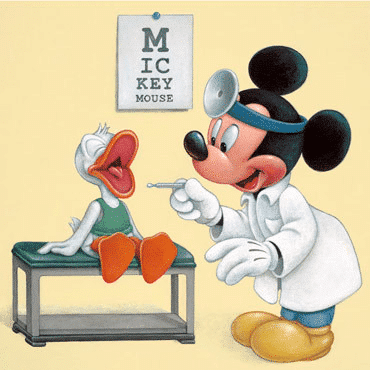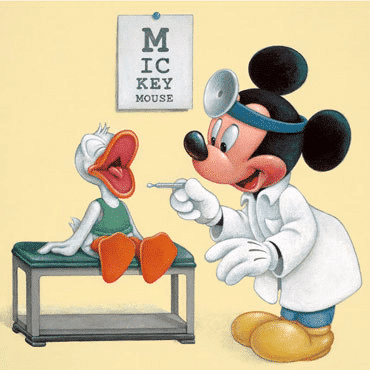If Disney Ran Your Urgent Care Center

The day Disneyland opened, Walt Disney declared, “At Disneyland, the visitors are our guests.” Walt was an incredible visionary and innovator whose legacy continues today. The culture he created combined with Walt’s unwavering commitment to excellence prompted Fred Lee to author the bestseller, If Disney Ran Your Hospital.
Disney’s recognition of the ‘guest experience’ and his assiduous oversight of every detail related to that experience suffered after his departure – until Disney’s leadership returned to his core values. “What Would Walt Do?” became the mantra again. He had always defined visitors as “guests” and employees in the park as its “cast members.” The result? In May 2015, Forbes named Disney #11 on the list of The World’s Most Valuable Brands.
In urgent care or any other health care setting, our patients are the equivalent of Disney’s ‘guests,’ but I am not certain that we and our cast members consistently think of them in that light. In everything we do, we need to be thinking: What is the guest experience when they walk into our healthcare centers and what will make them return?
Why Providing Quality Healthcare Isn’t Enough
Frederick Reichheld, a director emeritus of Bain & Company has researched why the customer experience matters. In Loyalty Rules! How Leaders Build Lasting Relationships, he reminds us that it costs five times more to garner a new customer than to retain an existing one. Perhaps even more compelling is how he outlines the economics; a 5% increase in customer retention results in 25-95% increase in profits.
So increasing profits doesn’t have to be about a costly and potentially risky marketing campaign or seeking new product lines and services. It can be as simple as retaining the folks who’ve already crossed your threshold. Once you’ve expended resources and gotten them to make that initial decision, it’s much easier to get patients to return than start from scratch and convince someone new. Based on the types of returns defined by Mr. Reichheld, it makes sense to invest to ensure existing patients return, before all other marketing initiatives as there is the potential for substantial bottom line impact with the least amount of effort and risk.
So How Do I Create a Loyal Patient to My Urgent Care or Retail Health Center?
Disney got it. He knew that the experience was in the details and he was relentless in his commitment to ensure the park was, first and foremost, a safe environment. He built on the experience from that foundation. If you go to Disney’s website today, you will find a link to their Annual Safety Report! How many organizations, particularly in healthcare, are comfortable being that transparent? Is yours?
The Urgent Care Association of America created an accreditation program founded on three pillars:
-
Scope,
-
Quality and
-
Safety
with the initial objective that raising the bar with standards and criteria in these areas would also elevate the industry as a whole.
Based on the wisdom of Disney and the economics described by Mr. Reichheld, those organizations committed to excellence should also realize greater patient loyalty, and therefore, profitability. So where do you begin?
Safety First When Delivering Retail Healthcare
Just as Disney built on a foundation of safety first, urgent care operators should think safety for their patients and employees. Are you comfortable posting your safety report? Have you taken time to consider a formalized strategy for a safe environment? Safety begins with your leased or owned space and all that goes in it in the form of furniture, fixtures and equipment (FFE).
Operators are quick to cite items such needlestick and sharps injuries in their safety program but then fail to consider obvious safety hazards in the environment itself. And when a center is in disrepair or details are neglected, your patients notice…and will flee in a moment’s notice. After all, if you don’t care about the environment and the experience, why should they return when the competitor down the street does?
Start with key safety threats and then move onto those items that may not necessarily pose a safety issue, but reflect poorly on the center itself. For example, would Disney have allowed his guests to recline on an examination table and peer up at a series of water-stained ceiling tiles? Not on your life…
POTENTIAL URGENT CARE / RETAIL HEALTH CENTER SAFETY THREATS
|
Building a Patient Focused, Experience Driven Team
A wise colleague who owned a successful business told me that she always thought of her business team in concentric circles. Her employees were at the center, her advisors such as her accountants and legal counsel were in the next circle, and then came all the vendors and partners who were important to the ultimate smooth operations and success of her business.
They included the night cleaning crew, the pest control company, her external IT support and a myriad of vendors (and contractors) who made her business tick. She always wanted to make sure they understood that they weren’t simply vendors but key members of her success team. It was a culture she created and those vendors didn’t want to let her down. She was a priority to them and benefited as a result.
When creating your patient experience, think about your own concentric circles. Who exists today and are they adding to the patient experience or detracting from it? Who can you add? How do you make sure that you are their priority? And do you have the technology systems in place to objectively measure everyone’s performance to make sure you deliver on your quality of care mission.
When it comes to a safe and pleasing environment, your employees are unlikely to have the talent and more importantly the time, to actually do the majority of the work, be it normal maintenance, scheduled services or on-demand repairs. The urgent care center staff’s core competency is evaluating, diagnosing and treating non-life and limb threatening illnesses and injuries, but they can be tuned in to identify potential hazards and report these to make sure they’re addressed promptly and cost-effectively
Making a Safe, Visually Inviting Environment a Retail Healthcare Core Competency
Service automation software (sometimes called healthcare facilities management (FM) software or computerized maintenance management systems (CMMS)) is an important step in creating a safe, aesthetically pleasing environment. Committing to one of these software systems allows the urgent care operator to align with ‘concentric circle’ partners whose core competency is safety, repair and maintenance.
With healthcare FM software, the manager is connected with qualified, proven and reputable service professionals, and can manage these contractors’ credentials/insurance along with all the on-demand and planned service requests and work orders. And importantly, with such technology, you and your team can get reports with actionable data and metrics that would support your “Disneyesque” commitment to safety.
You may not want to go as far as publishing your annual safety report on your website – although it would be a differentiator – but you can certainly market your core values, including patient safety, and your commitment to the patient experience with the confidence that your center is a true reflection of those values.
Be Disneyesque and Realize the Return
A loyal patient is a valuable asset that should be pursued relentlessly and your ‘established’ patients as a percentage of total volume is a metric easily tracked. Established patients have returned to you because they mostly likely had a positive experience. If that percentage is waning without good explanation, profitability will suffer. Disney never compromised nor should you. It takes planning and consideration of who best fits into your concentric circles and the role each plays in our business success.
A service automation partner provides a quick and one-stop solution to identify a myriad of service vendors (and contractors) who will consider your business a priority. The selected vendors care about their work performance in your center because their reputation with you, as well as their opportunities for future work depend on it. With today’s technology, you have the ability to manage all your work orders and provide feedback on all the work performed at your locations, rate your experience, and objectively and quantitatively measure vendor performance.
Urgent care center operators are urged to consider the return on investment (ROI) on the modest cost associated with healthcare FM software, and its ultimate impact on a center’s environment of care, the patient experience – and subsequent and ongoing business growth.
Walt Disney didn’t intend for you to go to Disneyland just once. He set a strategy to ensure that it was a destination for years and generations to come. When considering the opportunity to retain your existing patient base without leakage, and gain new patient volume through enthusiastically favorable word of mouth, the ROI on facility management (FM) software is simply too great to ignore.
Disney is said to have constantly reminded his leadership to never forget that the empire they built “all began with a mouse.” We, as urgent care operators, cannot lose sight of what made us successful in the beginning. When a new business opens, we pay great attention to detail. How are patients greeted? What is my door-to-door time? How does the facility look when you walk in the door? How well is the signage seen during the day and night?
We can and should harness the latest web- and mobile-based technology to simplify how we maintain that same level of attention to detail as we grow. If you do, you’ll ensure your ‘guests’ serve as your #1 source of advertisement, referral and growth.
{{cta(‘f9a06465-6f00-45d9-9160-72748a0d1202′,’justifycenter’)}} Laurel Stoimenoff earned a degree in Physical Therapy & Allied Medicine but quickly entered multi-site, multi-state management with leadership roles with physical therapy, diagnostic imaging and finally urgent care organizations. In late 2011, Laurel and a colleague founded Continuum Health Solutions, a consulting firm with a focus on the urgent care industry. Continuum’s clients include hospitals, physician groups, private equity, occupational medicine organizations and entrepreneurs. Laurel served seven years as a Board member of the Urgent Care Association of America, including its Treasure and Vice President. She Chairs the Health & Public Policy Committee and Co-Chairs the Accreditation Committee. Laurel also serves as a Trustee of the Urgent Care Foundation.



